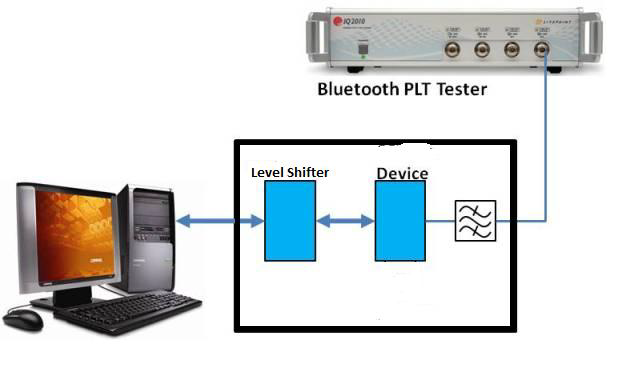SWRA750 September 2022
1.4 BER Meter Test
A bit error rate (BER) meter test of the DUT is designed primarily for testing of BT sensitivity by the Bluetooth SIG spec (- 70dBm per BT standard).
The context below describes the HCI_VS_DRPb_BER_Meter_Start command and parameters used in this example:
- Op code: 0xFD8B
- Frequency Channel
- 0-39: f=2402+(2*i)MHz
- 40-78: f=2403+2(i-40)MHz
 Figure 1-2 Wilink_X Bluetooth PLT
Mode Test Setup
Figure 1-2 Wilink_X Bluetooth PLT
Mode Test Setup - Reserved (0x00)
- BD Address
- Is expressed as Little Endian
- Must match the MAC (BD) address as specified by the transmitter
- Actual MAC address of 12:34:56:78:12:34 would be 34:12:78:56:34:12
- LT Address (0x01) - address of the device in the piconet (not applicable, set to 1)
- ACL TX packet type
- 0=DM1
- 1=DH1
- 2=DM3
- 3=DH3
- 4=DM5
- 5=DH5
- 6=2-DH1
- 7=2-DH3
- 8=2-DH5
- 9=3-DH1
- A=3-DH3
- B=3-DH5
- Packet length
- DM1: 0-17
- DH1: 0-27
- DM3: 0-121
- DH3: 0-183
- DM5: 0-224
- DH5: 0-339
- Number of packets to be used for the BER test (0x0000-0xFFFF)
- PRBS initialize (0x1FF)
- Poll period = 0x1
- Poll period of 5 means that every fifth packet received is used in the BER calculation (longer test time)
- Poll period of 1 means every packet received is used in the BER calculation (shortest test time)
Because there are different ACL packet types that are comprised of different packet lengths, the number of packets transmitted must be changed to accommodate the different packet sizes in order to still send 1.6MBits. The chart below illustrates the different packet types and number of packets needed to conduct a BER test as per the BT 4.1 spec:
| Type | User Payload (bytes) | Num packets to send for BER test |
|---|---|---|
| DM1 | 0-17 | 11765 |
| DH1 | 0-27 | 7408 |
| DM3 | 0-121 | 1653 |
| DH3 | 0-183 | 1093 |
| DM5 | 0-224 | 893 |
| DH5 | 0-339 | 590 |
| AUX1 | 0-29 | 6897 |
| 2-DH1 | 0-54 | 3704 |
| 2-DH3 | 0-367 | 545 |
| 2-DH5 | 0-679 | 295 |
| 3-DH1 | 0-83 | 2410 |
| 3-DH3 | 0-552 | 363 |
| 3-DH5 | 0-1021 | 196 |
The BER test can be achieved in two different configurations, either:
- Two Wilink devices (one designated as the TX and the other as the RX) OR
- One Wilink device and 1 Litepoint iQ2010 Tester (Wilink as the RX and Litepoint as the TX)